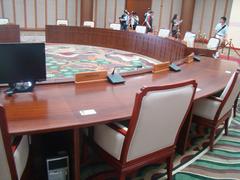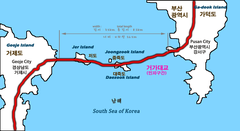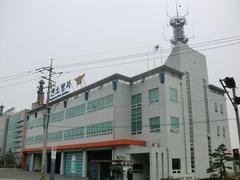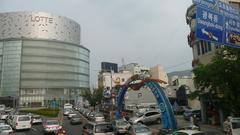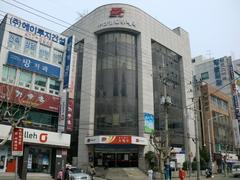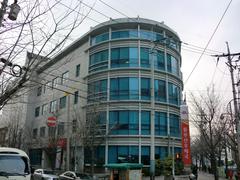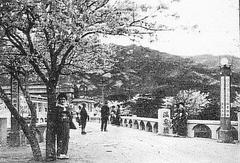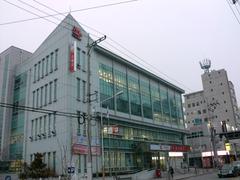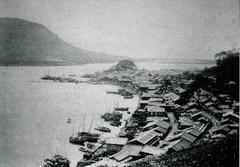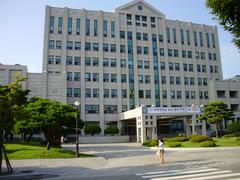Geojehaemaji Station Visiting Hours, Tickets, and Travel Guide: Busan Historical Sites
Date: 04/07/2025
Introduction: Geojehaemaji Station – A Gateway to Busan’s Heritage and Coast
Geojehaemaji Station (거제해맞이역), located in the Geoje-dong district of Yeonje-gu, Busan, is more than a modern transit hub—it’s a portal to the city’s maritime history, scenic coastlines, and vibrant cultural life. Part of the Donghae Line, the station’s name, meaning “Geoje Sunrise Station,” is a nod to its popularity among sunrise chasers and its picturesque coastal setting (Road Affair). With bilingual signage, accessible infrastructure, and seamless ticketing, it is designed to serve both daily commuters and travelers eager to experience Busan’s charm and heritage (Travel80; Namu Wiki).
This guide covers everything you need to know about visiting Geojehaemaji Station: operating hours, ticketing, accessibility, nearby attractions, and travel tips to ensure a smooth and enriching visit to one of Busan’s most scenic locales (Haps Korea).
Table of Contents
- Historical Evolution: Busan’s Foundations and Geojehaemaji Station
- Geojehaemaji Station – Visitor Information
- Nearby Attractions: History, Culture, and Nature
- Community Events, Tours, and Photographic Spots
- Station Layout and Facilities
- Local Transportation Integration
- Getting to Geojehaemaji Station
- Frequently Asked Questions (FAQs)
- Visual Resources and Suggested Images
- Key Travel Recommendations
- Sources and Further Reading
Historical Evolution: Busan’s Roots and the Rise of Geojehaemaji Station
Ancient and Medieval Periods
Busan’s strategic position as a port city has shaped its history since the Gaya confederacy and Three Kingdoms era. The port’s growth during the Silla, Goryeo, and Joseon dynasties established it as a center for trade and cultural exchange, laying the groundwork for the modern city and its transit systems (Travel80).
Colonial Modernization and Urban Expansion
The late 19th and early 20th centuries, especially under Japanese colonial rule, saw Busan’s transformation into a major urban center. Railways like the Gyeongbu Line were developed to connect Busan regionally and nationally, leading to the later establishment of suburban stations like Geojehaemaji. This expansion was crucial for supporting city growth and economic vitality (Namu Wiki).
Post-War Growth and Modern Transit
Following the Korean War, Busan’s rapid urbanization and industrialization led to the expansion of transport infrastructure. The Donghae Line, and by extension Geojehaemaji Station, emerged from these efforts, making the city’s outlying districts more accessible and supporting both residential and tourism development.
Geojehaemaji Station – Visitor Information
Visiting Hours
- Operating Hours: Approximately 5:00–5:30 AM to midnight daily, in sync with the Donghae Line schedule (Korail).
- Tip: Early morning and late-night trains may have reduced frequency. Check the Korail website or local apps for current timetables.
Ticket Prices and Purchase Options
- Fares: Start at around ₩1,250–1,300 for short trips within Busan. Prices depend on distance.
- How to Buy: Tickets are available from station vending machines (multilingual), ticket counters, or via rechargeable IC cards (T-Money, Cashbee, Korea Tour Card).
- Contactless Payment: IC cards are accepted on all local trains, subways, and buses, offering convenience and discounts (Road Affair).
- Online/Apps: Some Korean transit apps allow for mobile ticketing and balance top-ups.
Accessibility
Geojehaemaji Station is fully accessible:
- Elevators, ramps, and tactile paving for mobility-impaired travelers.
- Multilingual signage (Korean, English, Chinese, Japanese).
- Accessible restrooms and audio-visual train announcements (KoreaToDo).
Practical Travel Tips
- Arrive early during rush hours for stress-free navigation.
- Use IC cards for seamless transfers and cost savings.
- Download transit/navigation apps (KakaoMap, Naver Map) for real-time updates.
- Station staff provide assistance; use translation apps for more complex questions.
Nearby Attractions: History, Culture, and Nature
From Geojehaemaji Station, visitors can easily reach some of Busan’s top attractions:
- Beomeosa Temple: A historic Buddhist temple on Mt. Geumjeong, about 20–30 minutes by bus or taxi.
- Gamcheon Culture Village: Renowned for its colorful hillside houses, street art, and cafes.
- Songdo Beach & Cable Car: A seaside destination with panoramic views, accessible in 15–20 minutes.
- Geoje Haemaji Park: Popular for sunrise views and local New Year celebrations.
- Busan Citizens Park: Ideal for picnics and seasonal events.
For more cultural exploration, local markets, traditional eateries, and coastal trails are within easy reach (A Love Letter to Asia; Korea Travel Planning).
Community Events, Tours, and Photospots
Geojehaemaji Station hosts and connects visitors to community events such as:
- Busan Sea Festival and Heritage Night, celebrating local culture (Haps Korea).
- Guided walking tours departing from the station, exploring historic and coastal districts.
- Ideal photographic locations: sunrise at Geoje Haemaji Park, harbor views, and vibrant neighborhoods.
Station Layout and Facilities
- Platforms: Two ground-level side platforms with safety features.
- Entrances/Exits: Multiple, all barrier-free (elevators, ramps).
- Fare Gates: Automated, accepting IC cards and paper tickets.
- Waiting Areas: Sheltered benches, climate-controlled waiting room, digital displays for train times.
- Amenities: Clean restrooms, baby changing stations, coin lockers, convenience stores (GS25, 7-Eleven), cafes, vending machines.
- Connectivity: Free Wi-Fi, charging stations, CCTV, emergency call points.
- Accessibility: Tactile paving, accessible restrooms, and audio-visual announcements for all users (Reddit).
Integration with Local Transport
- Bus Connections: Stops at the station entrance link to Yeonje and other districts. Route maps and timetables are displayed on-site and in navigation apps (PrepareTravelPlans).
- Taxis: Stand adjacent to station; metered fares apply.
- Bicycle Parking: Secure racks for standard and electric bikes.
- Nearby Amenities: Restaurants, pharmacies, ATMs, and small hotels or guesthouses are within walking distance.
Getting to Geojehaemaji Station
- By Donghae Line: Direct service with air-conditioned, multilingual trains running every 15–30 minutes. Connect at Bujeon or Centum City Station for metro transfers (Busan Metropolitan City).
- By Bus: Color-coded network (blue, green, red) with T-Money or Cashbee card payment (Zen Moments in Korea).
- By Taxi/Rideshare: Book via Kakao Taxi app; fares from central Busan start around 3,800 KRW.
- Airport/Intercity: From Gimhae Airport, take BGLRT to Sasang, transfer to Line 2 (Bujeon), then Donghae Line to Geojehaemaji.
Frequently Asked Questions (FAQs)
Q: What are Geojehaemaji Station’s operating hours?
A: Generally 5:00–5:30 AM to midnight, matching Donghae Line schedules.
Q: How do I buy tickets?
A: Use vending machines (supporting multiple languages), station counters, or T-Money/Cashbee cards.
Q: Is the station accessible for travelers with disabilities?
A: Yes. Elevators, ramps, tactile paving, and accessible restrooms are available.
Q: Are there food and retail options at the station?
A: Yes, including convenience stores, cafes, and vending machines.
Q: How can I connect to local buses or taxis?
A: Bus stops and a taxi stand are just outside the entrances.
Q: Are guided tours available?
A: While not offered at the station itself, nearby tourist centers and hotels provide tours to Busan’s attractions.
Visual Resources and Suggested Images
- Exterior of Geojehaemaji Station at sunrise (alt: “Geojehaemaji Station with sunrise views”)
- Interior concourse featuring modern architecture (alt: “Interior of Geojehaemaji Station with natural light”)
- Sunrise at Geoje Haemaji Park (alt: “Sunrise at Geoje Haemaji Park near Geojehaemaji Station”)
- Map of station location on the Donghae Line (alt: “Map of Geojehaemaji Station on Busan Donghae Line”)
- Photos of nearby attractions like Beomeosa Temple, Gamcheon Culture Village, and Busan Citizens Park
Key Travel Recommendations
- Use IC cards (T-Money, Cashbee): Streamlines transit across trains, buses, and subways.
- Check schedules: Use Korail or local apps for up-to-date information.
- Travel at sunrise: For the best views and tranquil atmosphere.
- Explore beyond the station: Visit local parks, markets, and historic sites.
- Utilize navigation apps: KakaoMap or Naver Map are most reliable for transit in Busan (Torn Tackies).
Sources and Further Reading
- Travel80: Busan History and Heritage
- Namu Wiki: Busan Station
- Road Affair: Visiting Busan Guide
- Haps Korea: 2025 Busan Major Event Schedule
- Korea Travel Planning: Things to Do in Busan
- Korail: LetsKorail Official Site
- Busan Metropolitan City: Public Transportation
- Visit Busan: History of Busan

